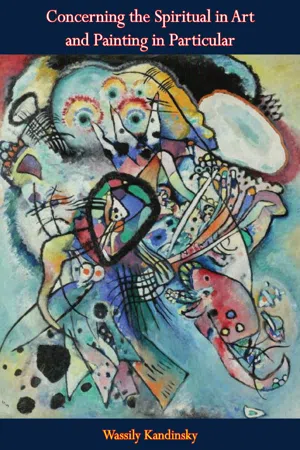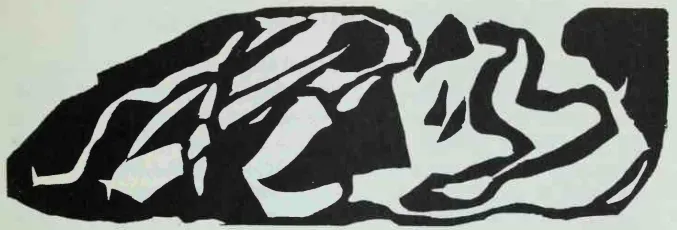![]()
ABOUT PAINTING
THE PSYCHOLOGICAL WORKING OF COLOUR
To let the eye stray over a palette, splashed with many colours, produces a dual result. In the first place one receives a purely physical impression, one of pleasure and contentment at the varied and beautiful colours. The eye is either warmed or else soothed and cooled. But these physical sensations can only be of short duration. They are merely superficial and leave no lasting impression, for the soul is unaffected. But although the effect of the colours is forgotten when the eye is turned away, the superficial impression of varied colour may be the starting point of a whole chain of related sensations.
On the average man only the impressions caused by very familiar objects, will be purely superficial. A first encounter with any new phenomenon exercises immediately an impression on the soul. This is the experience of the child discovering the world, to whom every object is new. He sees a light, wishes to take hold of it, burns his finger and feels henceforward a proper respect for flame. But later he learns that light has a friendly as well as an unfriendly side, that it drives away the darkness, makes the day longer, is essential to warmth, cooking, playacting. From the mass of these discoveries is composed a knowledge of light, which is indelibly fixed in his mind. The strong, intensive interest disappears and the various properties of flame are balanced against each other. In this way the whole world becomes gradually disenchanted. It is realized that trees give shade, that horses run fast and motor-cars still faster, that dogs bite, that the figure seen in a mirror is not a real human being.
As the man develops, the circle of these experiences caused by different beings and objects, grows ever wider. They acquire an inner meaning and eventually a spiritual harmony. It is the same with colour, which makes only a momentary and superficial impression on a soul but slightly developed in sensitiveness. But even this superficial impression varies in quality. The eye is strongly attracted by light, clear colours, and still more strongly attracted by those colours which are warm as well as clear; vermilion has the charm of flame, which has always attracted human beings. Keen lemon-yellow hurts the eye in time as a prolonged and shrill trumpet-note the ear, and the gazer turns away to seek relief in blue or green.
But to a more sensitive soul the effect of colours is deeper and intensely moving. And so we come to the second main result of looking at colours: their psychic effect. They produce a corresponding spiritual vibration, and it is only as a step towards this spiritual vibration that the elementary physical impression is of importance.
Whether the psychic effect of colour is a direct one, as these last few lines imply, or whether it is the outcome of association, is perhaps open to question. The soul being one with the body, the former may well experience a psychic shock, caused by association acting on the latter. For example, red may cause a sensation analogous to that caused by flame, because red is the colour of flame. A warm red will prove exciting, another shade of red will cause pain or disgust through association with running blood. In these cases colour awakens a corresponding physical sensation, which undoubtedly works upon the soul.
If this were always the case, it would be easy to define by association the effects of colour upon other senses than that of sight. One might say that keen yellow looks sour, because it recalls the taste of a lemon.
But such definitions are not universally possible. There are many examples of colour working which refuse to be so classified. A Dresden doctor relates of one of his patients, whom he designates as an “exceptionally sensitive person,” that he could not eat a certain sauce without tasting “blue,” i.e. without experiencing a feeling of seeing a blue color.{24} It would be possible to suggest, by way of explanation of this, that in highly sensitive people, the way to the soul is so direct and the soul itself so impressionable, that any impression of taste communicates itself immediately to the soul, and thence to the other organs of sense (in this case, the eyes). This would imply an echo or reverberation, such as occurs sometimes in musical instruments which, without being touched, sound in harmony with some other instrument struck at the moment.
But not only with taste has sight been known to work in harmony. Many colours have been described as rough or sticky, others as smooth and uniform, so that one feels inclined to stroke them (e.g., dark ultramarine, chromic oxide green, and rose madder). Equally the distinction between warm and cold colours belongs to this connection. Some colours appear soft (rose madder), others hard (cobalt green, blue-green oxide), so that even fresh from the tube they seem to be dry.
The expression “scented colours” is frequently met with. And finally the sound of colours is so definite that it would be hard to find anyone who would try to express bright yellow in the bass notes, or dark lake in the treble.{25}, {26} The explanation by association will not suffice us in many, and the most important cases. Those who have heard of chromotherapy will know that coloured light can exercise very definite influences on the whole body. Attempts have been made with different colours in the treatment of various nervous ailments. They have shown that red light stimulates and excites the heart, while blue light can cause temporary paralysis. But when the experiments come to be tried on animals and even plants, the association theory falls to the ground. So one is bound to admit that the question is at present unexplored, but that colour can exercise enormous influence over the body as a physical organism.
No more sufficient, in the psychic sphere, is the theory of association. Generally speaking, colour is a power which directly influences the soul. Colour is the keyboard, the eyes are the hammers, the soul is the piano with many strings. The artist is the hand which plays, touching one key or another, to cause vibrations in the soul.
It is evident therefore that colour harmony must rest only on a corresponding vibration in the human soul; and this is one principles of the inner need.{27}
![]()
THE LANGUAGE OF FORM AND COLOUR
The man that hath no music in himself,
Nor is not mov’d with concord of sweet sounds,
Is fit for treasons, stratagems, and spoils;
The motions of his spirit are dull as night,
And his affections dark as Erebus:
Let no such man be trusted. Mark the music.
(The Merchant of Venice, Act v, Scene I.)
Musical sound acts directly on the soul and finds an echo there because, though to varying extents, music is innate in man.{28}
“Everyone knows that yellow, orange, and red suggest ideas of joy and plenty” (Delacroix).{29}
These two quotations show the deep relationship between the arts, and especially between music and painting. Goethe said that painting must count this relationship her main foundation, and by this prophetic remark he seems to foretell the position in which painting is today. She stands, in fact, at the first stage of the road by which she will, according to her own possibilities, make art an abstraction of thought and arrive finally at purely artistic composition.{30}
Painting has two weapons at her disposal:
1. Colour.
2. Form.
Form can stand alone as representing an object (either real or otherwise) or as a purely abstract limit to a space or a surface.
Colour cannot stand alone; it cannot dispense with boundaries of some kind.{31} A never-ending extent of red can only be seen in the mind; when the word red is heard, the colour is evoked without definite boundaries. If such are necessary they have deliberately to be imagined. But such red, as is seen by the mind and not by the eye, exercises at once a definite and an indefinite impression on the soul, and produces spiritual harmony. I say “indefinite,” because in itself it has no suggestion of warmth or cold, such attributes having to be imagined for it afterwards, as modifications of the original “redness.” I say “definite,” because the spiritual harmony exists without any need for such subsequent attributes of warmth or cold. An anal...


